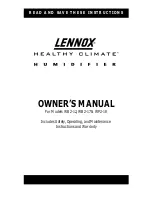
4
www.UsePhoenix.com • [email protected]
Toll-Free 1-800-533-7533
Take care to avoid secondary damages to the affected area
caused by over-drying or overheating.
The D850 will continue to remove water from air that is
already dry. It will also continue to heat the process outlet
air. Consider using an external humidistat and/or thermostat
(see Section 3.8.5) to control the conditions in the affected
area.
3.3 Transporting
The Phoenix D850 can be transported and stored either
upright or horizontally as shown in Figures 1 and 2 (on page
3). There is a storage compartment under the process air
filter, which is large enough to store the power cords and
additional small items that you may require on your job site.
3.4 Electrical Requirements
The Phoenix D850 requires 208-240VAC, single phase power.
When properly installed, it provides a ground connection
through the cord to the unit to protect the operator from
electric shock. The D850 comes equipped with two 8’ long
cords for connection to grounded residential range and dryer
receptacles. Accessory extension cord kits are also available
(see Accessories).
3.5 Location
Note the following precautions when locating the
Phoenix D850:
• It is designed to be used
INDOORS ONLY
.
• If used on a water loss work site, plug it into
GROUND
FAULT CIRCUIT INTERRUPT (GFCI) OUTLETS
• Maintain a minimum of 36” clearance around the D850
• DO NOT
use the Phoenix D850 as a bench or table.
3.6 Ducting Connections
Air flow and performance are reduced as the length of the
duct increases. Bends and other restrictions will also hurt
air flow and performance. Use the shortest, straightest duct
runs possible for best results.
Four different duct sizes can be used with the D850. All
ducting materials are available from Therma-Stor LLC (see
accessories list section 2).
Process in: 18” or 12” flex duct.
To attach 18” flex duct
to the process air intake,
push the wire of the
first couple of loops
down below the four
tabs in the top cover.
An adapter is included
that allows 12” flexible
ducting to be connected
to the inlet. It is stored
inside the process filter compartment. Push the 12” flex duct
through the adapter center with the adapter hooking tabs
facing away from duct; (see figure 4). The spiral wire passes
from one side of the adapter to the other via the notch on the
edge of the hole; (see figure 5). The adapter and duct are
positioned on the unit top with the four tabs placed into the
slots. The adapter is then twisted counterclockwise to lock it
in place; see figures 6 and 7.
Figure 3: Small Storage Compartment.
Figure 4:
Figure 5:
Figure 7:
Figure 6:





























